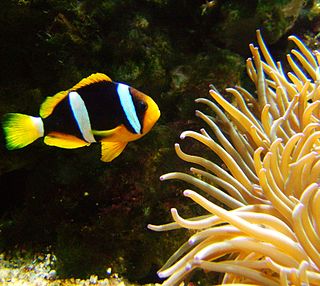
Amphiprion clarkii, known commonly as Clark's anemonefish and yellowtail clownfish, is a marine fish belonging to the family Pomacentridae, the clownfishes and damselfishes.
Nanochromis transvestitus is a sexually dimorphic cichlid endemic to Lake Mai-Ndombe in the Democratic Republic of the Congo where they live at a depth of around 1 metre (3.3 ft). It feeds on small benthic invertebrates. This species reaches a length of 3.4 centimetres (1.3 in) SL. Unusually for cichlids, it is the female, not the male, that is the most colourful. The female has a vertical black and white banding on her anal and caudual fins, with a bright red abdomen. The male, by contrast, is grayish in colour. Like many cichlids, the male does, however, have longer anal and caudal fins. The fish are egg layers and make a nest in the substrate in which to lay their eggs. This species is particularly threatened by the practice of using mosquito netting to catch fish out of the lake as material with holes that small catches every species of fish in the lake regardless of size. The specific name is a derived from the Latin trans meaning "cross" or "over" and vestitus meaning "clothed", a reference to the reversal of the normal sexual dimorphism in that this species has drabber males and more colourful females.
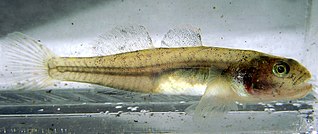
Eucyclogobius newberryi, the Northern tidewater goby, is a species of goby native to lagoons of streams along the coast of California, United States..

Istiblennius dussumieri, the streaky rockskipper, is a species of combtooth blenny found in coral reefs in the western Pacific and Indian Oceans. It is also commonly known as the Dussumier's rockskipper, streaky dussumier, or the Dussumier's blenny.
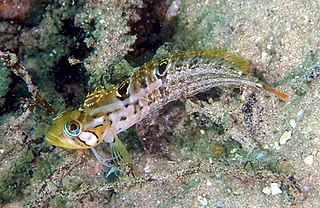
Clinus venustris, the speckled klipfish, is a species of clinid that occurs in subtropical waters of the Atlantic Ocean from Namibia to South Africa where it is found in the subtidal zone as well as being a denizen of tide pools. This species can reach a maximum length of 12 centimetres (4.7 in) TL. and feeds primarily on amphipods, isopods, mysids, and echinoderms.
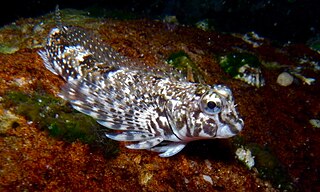
Lepidoblennius haplodactylus, known commonly as the eastern jumping blenny, is a species of triplefin blenny in the genus Lepidoblennius. It was described by Franz Steindachner in 1867 and is the type species of the genus Lepidoblennius.
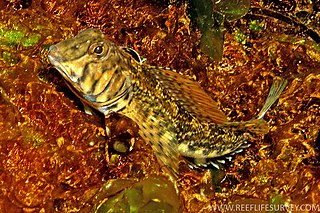
Lepidoblennius marmoratus, known commonly as the western jumping blenny, is a species of triplefin blenny in the genus Lepidoblennius. It was first described by William John Macleay in 1878.

The pike topminnow, also known as the top minnow, is a species of poeciliid found from Mexico to Costa Rica. It has also been introduced to Florida, USA. The female of the species grows to a length of 20 centimetres (7.9 in) TL, with males growing to a length of 10 centimetres (3.9 in) TL. It is the only known member of its genus. Unlike most poeciliids, this is a highly specialized predator, with an extremely flexible upper jaw that enables them to take very large prey items for their size. The piki topminnow was described in 1860 by the Austrian ichthyologist Rudolf Kner, Kner gave the type locality as Belize, which is reflected in this species specific name.
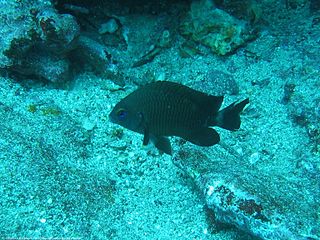
Stegastes beebei, is a species of damselfish found on coral and rocky reefs at depths between 0 and 15 m. They are somewhat territorial, and chase away small intruders. They are omnivorous, grazing on algae and nibbling at small crustaceans and the tentacles of anemones. They are oviparous, with distinct pairing during breeding. The eggs are demersal and adhere to the substrate. Males guard and aerate the eggs.

The arrow goby is a species of goby native to marine and brackish waters of the Pacific coast of North America from British Columbia to Baja California. This species grows to a length of 6.4 centimetres (2.5 in) SL, though most do not exceed 4.2 centimetres (1.7 in) TL. This fish can also be found displayed in public aquaria. This species is the only known member of its genus.

Valenciennea helsdingenii is a species of goby from the Indo-Pacific. It is commonly known as the twostripe goby, black-lined sleeper goby, or railway sleeper goby. It can grow up to a length of 25 cm (9.8 in) and is distinguishable by two prominent orange to black lines running longitudinally through its body.

The largetooth goby, also known as Wilbur's goby, is a species of ray-finned fish from the family Gobiidae which is native to the Indo-Pacific from the Seychelles to Micronesia. Its known range has been extended to the Red Sea as specimens were photographed at one site and collected at another site off Egypt. This species lives in sheltered marine waters at depths of from 0 to 20 metres preferring areas with sandy substrates. This species grows to a length of 6.5 centimetres (2.6 in) SL. This species is the only known member of its genus. This species is not obviously sexually dimorphic and it has a background colour of pale brown to greenish-brown and a pale ventral side. The body is marked with brown and white spots, pairs of larger brown spots create a mid-lateral row along its flanks and there is a dark spot on the caudal fin peduncle. It has a brown blotch on the cheek and a series of short brown bars along its back. The largetooth goby is a solitary fish which is found in coastal bays, lagoons and estuaries over fine sandy substrates close to the margins of reefs or silt beds in the vicinity of sheltered and often turbid coastal reefs. It is most frequently collected from shallow waters to 7 metres (23 ft), around coral reefs but off southern Japan, the largetooth goby occurs at the bottom of sandy bays. The specific name honours the American physician, Ray Lyman Wilbur (1875–1949) who was president of Stanford University from 1916–1943, as well as being the United States Secretary of the Interior from 1929–1933. Wilbur helped the author, Herre, get to Palau, the type locality of this species.

Selene setapinnis, the Atlantic moonfish, is a West Atlantic fish belonging to the family Carangidae.
Mugilogobius chulae, commonly known as the yellowstripe goby or Chulae's goby, is a species of freshwater, brackish goby, where it feeds on small crustaceans, aquatic insects and insect larvae. It is found in coastal eastern Asia from the Ryukyu Islands south to Sumatra.
Darwin's mudskipper is a relatively newly discovered mudskipper in 2004, so little is known about it. It is a brackish water ray-finned fish found in Australia along mud banks never far from mangrove trees. It is in the goby family Gobiidae. It is named after Charles Darwin because the holotype was collected in Darwin Harbour. Its greatest distinguishing characteristic from other mudskippers is its greatly reduced first dorsal fin in both sexes.

Diplecogaster bimaculata, the two-spotted clingfish, is a species of fish in the family Gobiesocidae found in Black Sea, Mediterranean Sea and Atlantic Ocean where it is found on rocks and among seagrass or shell beds.
Oxyurichthys petersii, Peters' goby, is a species of ray-finned fish, a goby, from the family Oxudercidae from the Red Sea, it has colonised the eastern Mediterranean Sea by Lessepsian migration through the Suez Canal.
Speleogobius llorisi, Llori's grotto goby, is a species of ray-finned fish, a true goby from the family Gobiidae. It was described in 2016 from specimens collected in the western Mediterranean Sea.
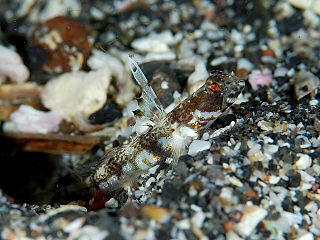
Tomiyamichthys alleni, Allen's shrimpgoby, is a species of ray-finned fish from the family Gobiidae. It occurs in the western Pacific Ocean where its is commensal with an aplheid shrimp.

Hirundichthys rondeletii, the black wing flyingfish, is a species of flying fish from the family Exocoetidae which is found throughout the tropical and subtropical waters of the Atlantic, Pacific and Indian Oceans.
















